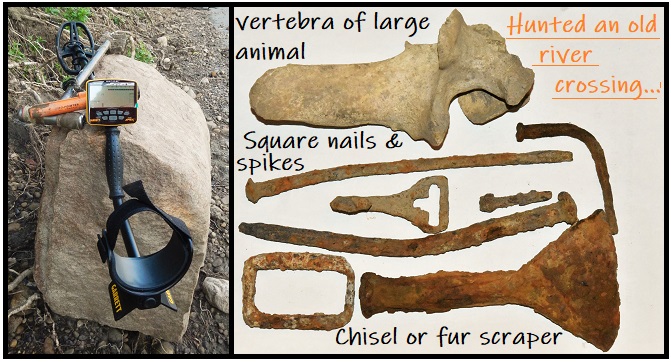I was fortunate enough to get a Garrett APEX unit early, as I live in Canada, and wanted to make sure that this new metal detector was at least as good as previous models designed and manufactured by Garrett for our coinage.. It needed to be able to read our Canadian coins as good targets. I field tested our coinage, had discussions with personal at Garrett, and even sent them a couple of sets of our coinage. One set was in pristine condition, the other contained coins I had previously dug up, in rather poor condition. I returned the APEX metal detector to Garrett, and anxiously waited for an updated model for comparisons.
I have always preferred to judge a metal detector on how well it performed overall, by using it in different environments and under different conditions. That's what this post is all about.
Well it recently arrived and I tried it out in different conditions, searching for different types of targets. I had previously (test model) already dug up a fair share of coinage. This updated model ran a lot more stable then the test model, and seemed to more sensitive to the different coins and tones of the coins.
The AT Pro is known for it's great ID characteristics, and is often times the choice for users to find coin/jewelry. It has been the best metal detector I have used to find Canadian coinage. The new Garrett APEX shares similar characteristics with the ability to pick out our coins. For example, older non - silver coins will most often give both a low and high signal. The high end of the signal will often get to the low 80's, then to a lower signal of 50 to 60. A signal like this must be investigated further, and is most often a Canadian nickel, dime of quarter. Newly minted Canadian Coins will be more stable and can read in the 70-80 VDI for a quarter, and just iron for nickel or dime. Our one and two dollar coins will both read in the high 70' or 80's, or, bounce around the 60's to the 80's, with a strong audio signal. Different years for our one and two dollar coins used different composition of metals. After you get used to the audio of the APEX, it is easy to guesstimate with good accuracy the size of a shallow target based on it's signal strength.
Garrett made a very smart move with this detector. They are aware that everyone who buys a metal detector, will at least once search for coins. Some people, lacking history and beach locations where they live, will become strictly coin and jewelry hunters. So, Garrett incorporated their very own local US coin program. So, foreigners get a detector more open to their coinage, and people in USA get their very own program. Brilliant!
I did metal detect in some old parks, in the woods, river bank and shallow water. One spot I spent several hours at, got me the usual iron targets, which by the way were plenty. In amongst the iron nails and spikes , I got a nice stable signal and pulled out an old musket ball. Throughout the search, I also got some more spent lead, shotgun shells and a variety of other finds. The separation of this new 6" x 11" DD Viper Searchcoil, seemed adequate. Several people have already used Monte's "Nail Board Test" as a reference for target separation and were quite pleased.
I spent an evening hunting an area along the North Sakatchewan River, which was at one time used as a snow dump, from ploughing heavy snow from roadways. I got the usual fishing tackle, some coins and aa few older relics as shown.
I love coin shooting, digging for jewelry, water detecting and finding older relics wherever I hunt. I did manage to get 3 rings......one in the woods and 2 in sports fields. All three rings gave off a nice clear signal, whith the coil going in all directions, which of course is why I decided to dig them. A soccer field gave up a nice butterfly brett and earrings
My first hunt with the Garrett APEX was actually a shallow freshwater water hunt. I wanted to just get used to the signals, and dig all the pull-tab signals hoping for a gold ring. To keep it simple, I hunted in jewelry mode, @ 5 KHz hoping to get a silver ring or coin. I manually ground balanced the APEX prior working the shallow water. I also attached the Garrett shoulder sling on the detector, in case I accidentally dropped it, the electronics wouldn't go in to the water. It took a little time to get used to the 5 different tones, and being able to adjust the iron audio is a real blessing. Although no rings popped up, I was rewarded with a nice silver quarter, at a nice 8 inches
This post contains photos of the finds for the first 10 hunts. The APEX is a very light, ergonomic metal detector. It has features on it which other metal detectors have, costing 2-3 x in price. I wish it was water proof, as the one shallow water hunt did get me a nice silver quarter at 8 inches, with a nice soft, repeatable high tone. However, my guess is that a water proof machine will probably be in the works soon. Hopefully, Garrett will soon come out with some different coil sizes. I would consider this coil as a medium size coil, suitable for most challenges, however, a smaller coil will get even more separation, and a larger coil will get more depth.
For more information on this new metal detector, go to the Garrett Website:
https://garrett.com/













